Reflections On Dyslexia Assignment 2022
VerifiedAdded on 2022/09/28
|6
|1576
|99
Assignment
AI Summary
Contribute Materials
Your contribution can guide someone’s learning journey. Share your
documents today.
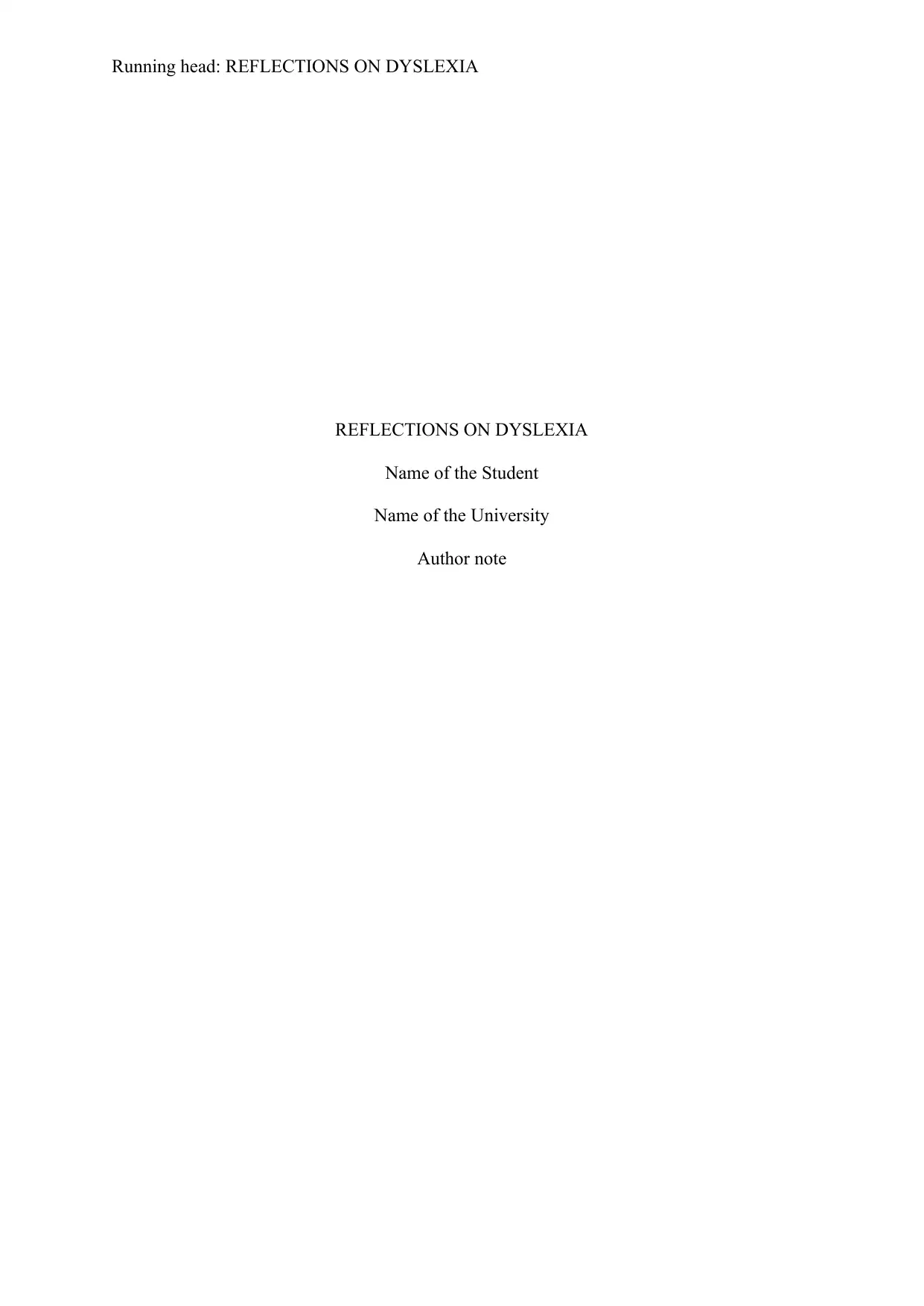
Running head: REFLECTIONS ON DYSLEXIA
REFLECTIONS ON DYSLEXIA
Name of the Student
Name of the University
Author note
REFLECTIONS ON DYSLEXIA
Name of the Student
Name of the University
Author note
Secure Best Marks with AI Grader
Need help grading? Try our AI Grader for instant feedback on your assignments.
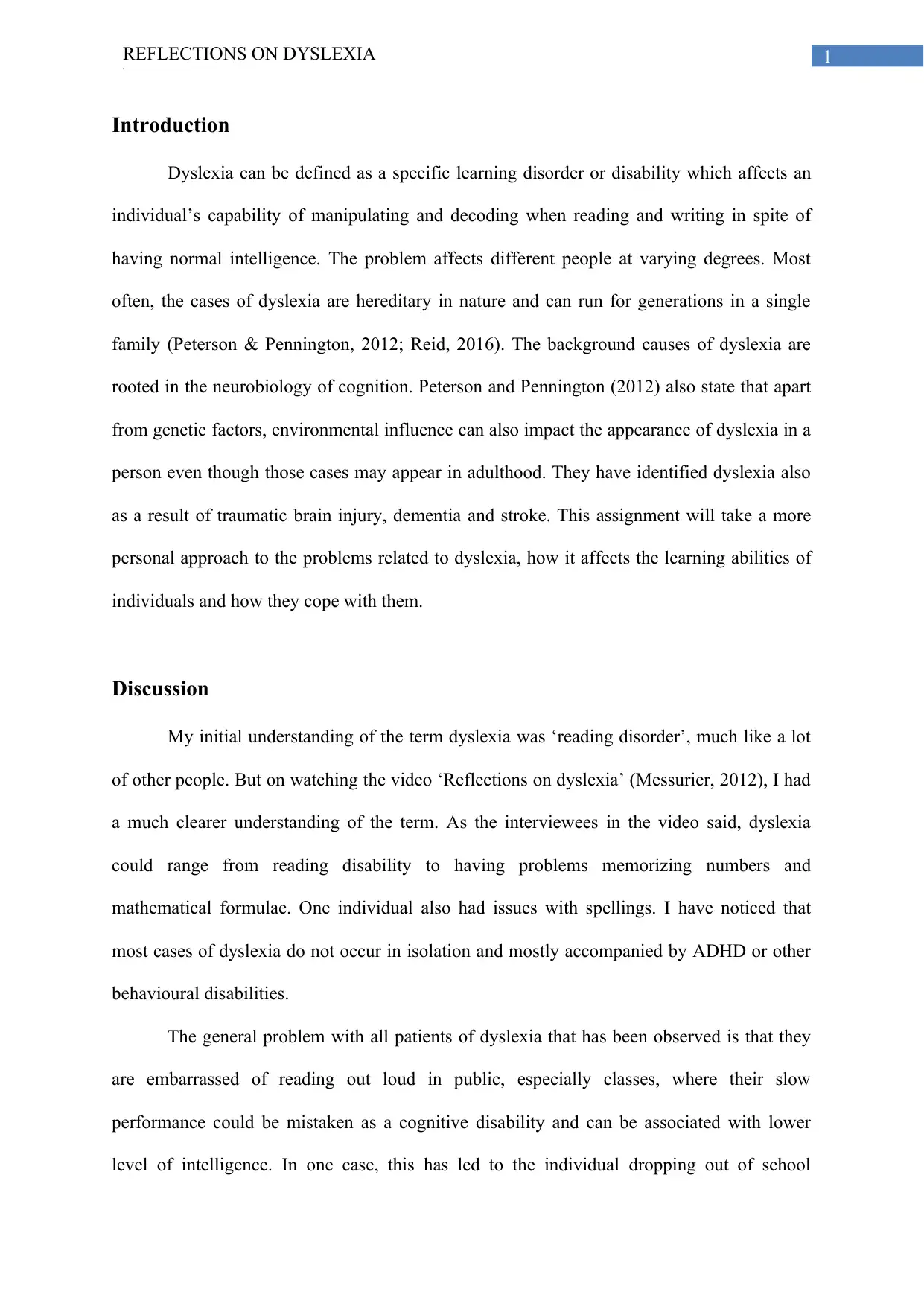
1REFLECTIONS ON DYSLEXIA
\
Introduction
Dyslexia can be defined as a specific learning disorder or disability which affects an
individual’s capability of manipulating and decoding when reading and writing in spite of
having normal intelligence. The problem affects different people at varying degrees. Most
often, the cases of dyslexia are hereditary in nature and can run for generations in a single
family (Peterson & Pennington, 2012; Reid, 2016). The background causes of dyslexia are
rooted in the neurobiology of cognition. Peterson and Pennington (2012) also state that apart
from genetic factors, environmental influence can also impact the appearance of dyslexia in a
person even though those cases may appear in adulthood. They have identified dyslexia also
as a result of traumatic brain injury, dementia and stroke. This assignment will take a more
personal approach to the problems related to dyslexia, how it affects the learning abilities of
individuals and how they cope with them.
Discussion
My initial understanding of the term dyslexia was ‘reading disorder’, much like a lot
of other people. But on watching the video ‘Reflections on dyslexia’ (Messurier, 2012), I had
a much clearer understanding of the term. As the interviewees in the video said, dyslexia
could range from reading disability to having problems memorizing numbers and
mathematical formulae. One individual also had issues with spellings. I have noticed that
most cases of dyslexia do not occur in isolation and mostly accompanied by ADHD or other
behavioural disabilities.
The general problem with all patients of dyslexia that has been observed is that they
are embarrassed of reading out loud in public, especially classes, where their slow
performance could be mistaken as a cognitive disability and can be associated with lower
level of intelligence. In one case, this has led to the individual dropping out of school
\
Introduction
Dyslexia can be defined as a specific learning disorder or disability which affects an
individual’s capability of manipulating and decoding when reading and writing in spite of
having normal intelligence. The problem affects different people at varying degrees. Most
often, the cases of dyslexia are hereditary in nature and can run for generations in a single
family (Peterson & Pennington, 2012; Reid, 2016). The background causes of dyslexia are
rooted in the neurobiology of cognition. Peterson and Pennington (2012) also state that apart
from genetic factors, environmental influence can also impact the appearance of dyslexia in a
person even though those cases may appear in adulthood. They have identified dyslexia also
as a result of traumatic brain injury, dementia and stroke. This assignment will take a more
personal approach to the problems related to dyslexia, how it affects the learning abilities of
individuals and how they cope with them.
Discussion
My initial understanding of the term dyslexia was ‘reading disorder’, much like a lot
of other people. But on watching the video ‘Reflections on dyslexia’ (Messurier, 2012), I had
a much clearer understanding of the term. As the interviewees in the video said, dyslexia
could range from reading disability to having problems memorizing numbers and
mathematical formulae. One individual also had issues with spellings. I have noticed that
most cases of dyslexia do not occur in isolation and mostly accompanied by ADHD or other
behavioural disabilities.
The general problem with all patients of dyslexia that has been observed is that they
are embarrassed of reading out loud in public, especially classes, where their slow
performance could be mistaken as a cognitive disability and can be associated with lower
level of intelligence. In one case, this has led to the individual dropping out of school
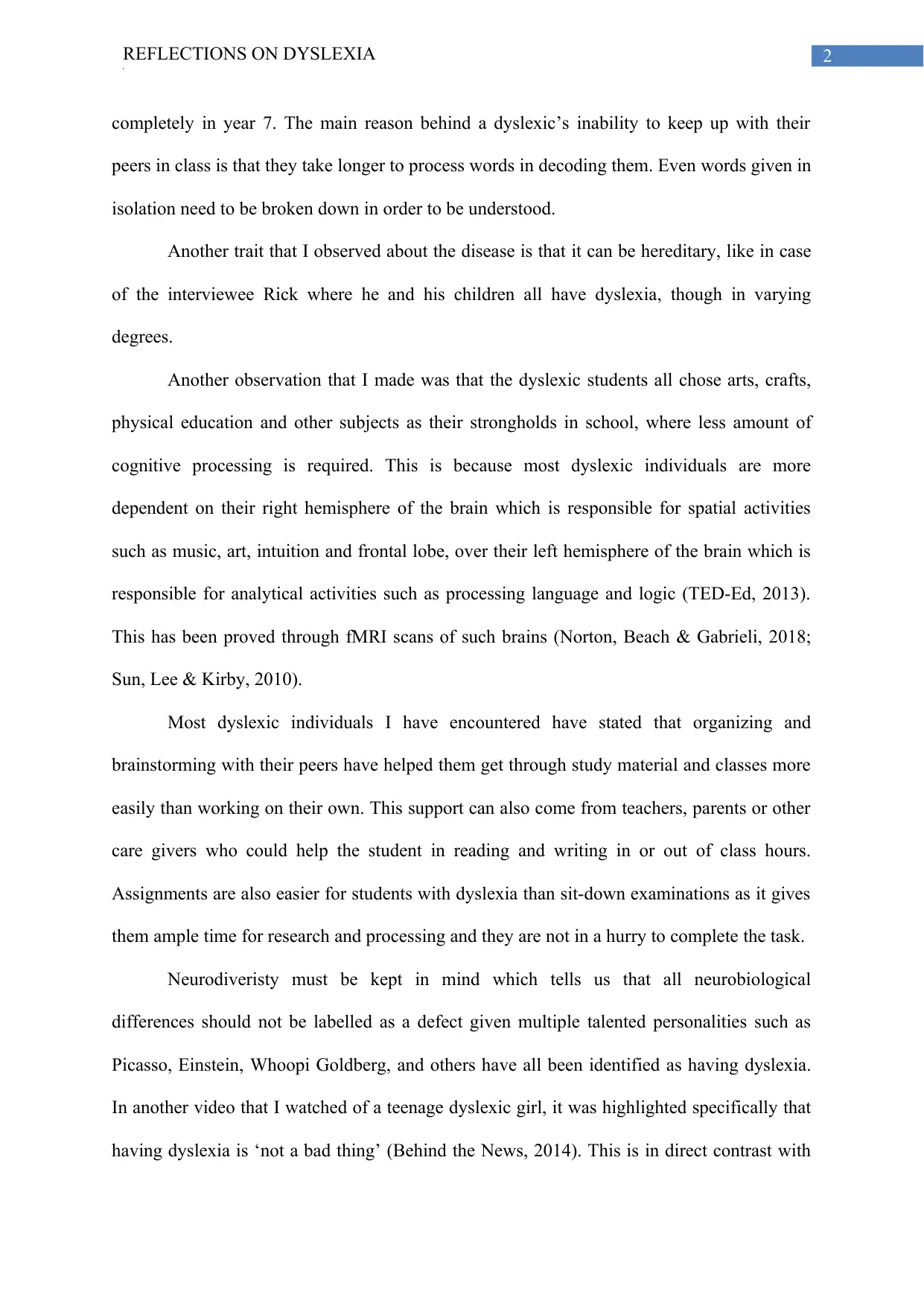
2REFLECTIONS ON DYSLEXIA
\
completely in year 7. The main reason behind a dyslexic’s inability to keep up with their
peers in class is that they take longer to process words in decoding them. Even words given in
isolation need to be broken down in order to be understood.
Another trait that I observed about the disease is that it can be hereditary, like in case
of the interviewee Rick where he and his children all have dyslexia, though in varying
degrees.
Another observation that I made was that the dyslexic students all chose arts, crafts,
physical education and other subjects as their strongholds in school, where less amount of
cognitive processing is required. This is because most dyslexic individuals are more
dependent on their right hemisphere of the brain which is responsible for spatial activities
such as music, art, intuition and frontal lobe, over their left hemisphere of the brain which is
responsible for analytical activities such as processing language and logic (TED-Ed, 2013).
This has been proved through fMRI scans of such brains (Norton, Beach & Gabrieli, 2018;
Sun, Lee & Kirby, 2010).
Most dyslexic individuals I have encountered have stated that organizing and
brainstorming with their peers have helped them get through study material and classes more
easily than working on their own. This support can also come from teachers, parents or other
care givers who could help the student in reading and writing in or out of class hours.
Assignments are also easier for students with dyslexia than sit-down examinations as it gives
them ample time for research and processing and they are not in a hurry to complete the task.
Neurodiveristy must be kept in mind which tells us that all neurobiological
differences should not be labelled as a defect given multiple talented personalities such as
Picasso, Einstein, Whoopi Goldberg, and others have all been identified as having dyslexia.
In another video that I watched of a teenage dyslexic girl, it was highlighted specifically that
having dyslexia is ‘not a bad thing’ (Behind the News, 2014). This is in direct contrast with
\
completely in year 7. The main reason behind a dyslexic’s inability to keep up with their
peers in class is that they take longer to process words in decoding them. Even words given in
isolation need to be broken down in order to be understood.
Another trait that I observed about the disease is that it can be hereditary, like in case
of the interviewee Rick where he and his children all have dyslexia, though in varying
degrees.
Another observation that I made was that the dyslexic students all chose arts, crafts,
physical education and other subjects as their strongholds in school, where less amount of
cognitive processing is required. This is because most dyslexic individuals are more
dependent on their right hemisphere of the brain which is responsible for spatial activities
such as music, art, intuition and frontal lobe, over their left hemisphere of the brain which is
responsible for analytical activities such as processing language and logic (TED-Ed, 2013).
This has been proved through fMRI scans of such brains (Norton, Beach & Gabrieli, 2018;
Sun, Lee & Kirby, 2010).
Most dyslexic individuals I have encountered have stated that organizing and
brainstorming with their peers have helped them get through study material and classes more
easily than working on their own. This support can also come from teachers, parents or other
care givers who could help the student in reading and writing in or out of class hours.
Assignments are also easier for students with dyslexia than sit-down examinations as it gives
them ample time for research and processing and they are not in a hurry to complete the task.
Neurodiveristy must be kept in mind which tells us that all neurobiological
differences should not be labelled as a defect given multiple talented personalities such as
Picasso, Einstein, Whoopi Goldberg, and others have all been identified as having dyslexia.
In another video that I watched of a teenage dyslexic girl, it was highlighted specifically that
having dyslexia is ‘not a bad thing’ (Behind the News, 2014). This is in direct contrast with
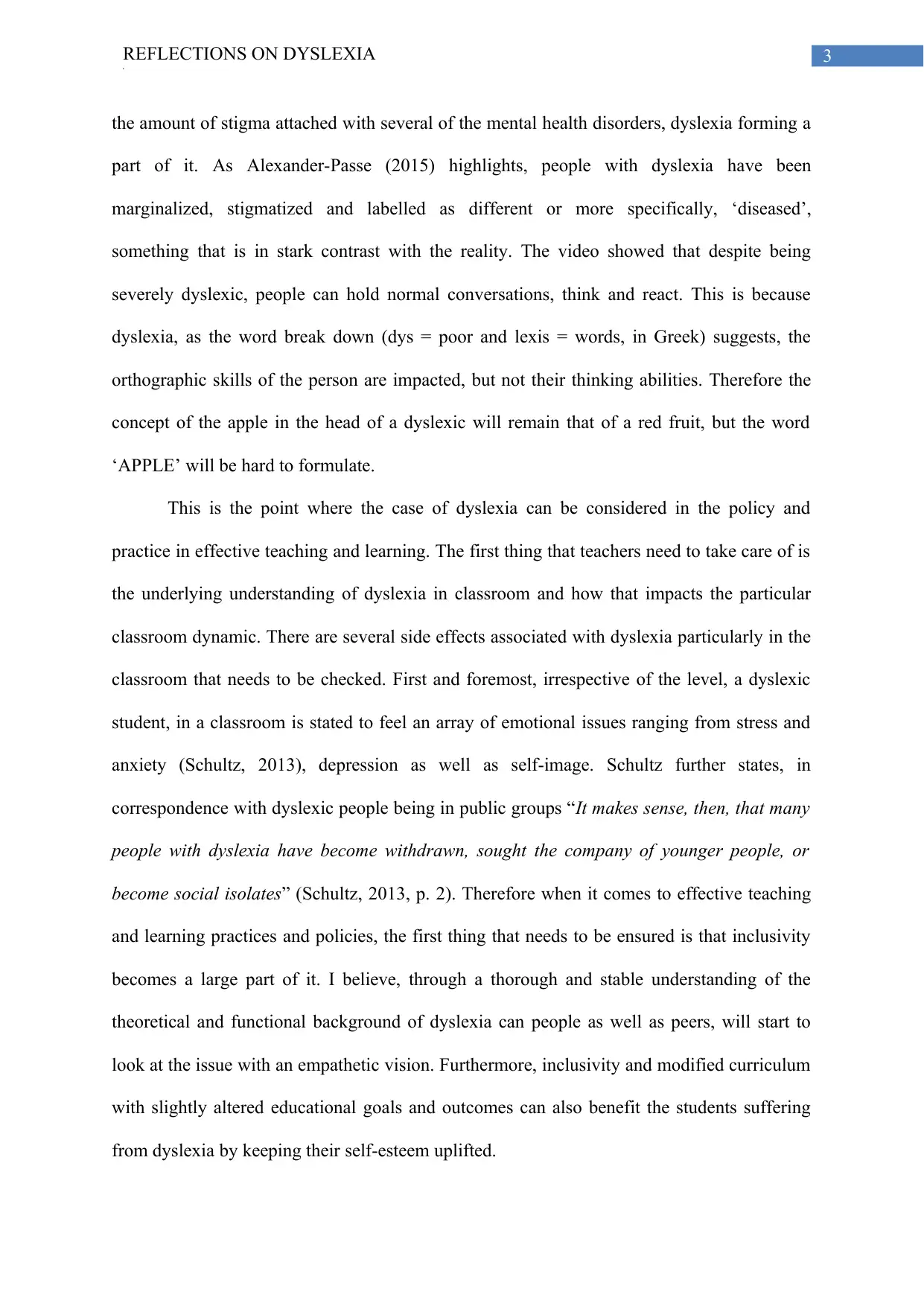
3REFLECTIONS ON DYSLEXIA
\
the amount of stigma attached with several of the mental health disorders, dyslexia forming a
part of it. As Alexander-Passe (2015) highlights, people with dyslexia have been
marginalized, stigmatized and labelled as different or more specifically, ‘diseased’,
something that is in stark contrast with the reality. The video showed that despite being
severely dyslexic, people can hold normal conversations, think and react. This is because
dyslexia, as the word break down (dys = poor and lexis = words, in Greek) suggests, the
orthographic skills of the person are impacted, but not their thinking abilities. Therefore the
concept of the apple in the head of a dyslexic will remain that of a red fruit, but the word
‘APPLE’ will be hard to formulate.
This is the point where the case of dyslexia can be considered in the policy and
practice in effective teaching and learning. The first thing that teachers need to take care of is
the underlying understanding of dyslexia in classroom and how that impacts the particular
classroom dynamic. There are several side effects associated with dyslexia particularly in the
classroom that needs to be checked. First and foremost, irrespective of the level, a dyslexic
student, in a classroom is stated to feel an array of emotional issues ranging from stress and
anxiety (Schultz, 2013), depression as well as self-image. Schultz further states, in
correspondence with dyslexic people being in public groups “It makes sense, then, that many
people with dyslexia have become withdrawn, sought the company of younger people, or
become social isolates” (Schultz, 2013, p. 2). Therefore when it comes to effective teaching
and learning practices and policies, the first thing that needs to be ensured is that inclusivity
becomes a large part of it. I believe, through a thorough and stable understanding of the
theoretical and functional background of dyslexia can people as well as peers, will start to
look at the issue with an empathetic vision. Furthermore, inclusivity and modified curriculum
with slightly altered educational goals and outcomes can also benefit the students suffering
from dyslexia by keeping their self-esteem uplifted.
\
the amount of stigma attached with several of the mental health disorders, dyslexia forming a
part of it. As Alexander-Passe (2015) highlights, people with dyslexia have been
marginalized, stigmatized and labelled as different or more specifically, ‘diseased’,
something that is in stark contrast with the reality. The video showed that despite being
severely dyslexic, people can hold normal conversations, think and react. This is because
dyslexia, as the word break down (dys = poor and lexis = words, in Greek) suggests, the
orthographic skills of the person are impacted, but not their thinking abilities. Therefore the
concept of the apple in the head of a dyslexic will remain that of a red fruit, but the word
‘APPLE’ will be hard to formulate.
This is the point where the case of dyslexia can be considered in the policy and
practice in effective teaching and learning. The first thing that teachers need to take care of is
the underlying understanding of dyslexia in classroom and how that impacts the particular
classroom dynamic. There are several side effects associated with dyslexia particularly in the
classroom that needs to be checked. First and foremost, irrespective of the level, a dyslexic
student, in a classroom is stated to feel an array of emotional issues ranging from stress and
anxiety (Schultz, 2013), depression as well as self-image. Schultz further states, in
correspondence with dyslexic people being in public groups “It makes sense, then, that many
people with dyslexia have become withdrawn, sought the company of younger people, or
become social isolates” (Schultz, 2013, p. 2). Therefore when it comes to effective teaching
and learning practices and policies, the first thing that needs to be ensured is that inclusivity
becomes a large part of it. I believe, through a thorough and stable understanding of the
theoretical and functional background of dyslexia can people as well as peers, will start to
look at the issue with an empathetic vision. Furthermore, inclusivity and modified curriculum
with slightly altered educational goals and outcomes can also benefit the students suffering
from dyslexia by keeping their self-esteem uplifted.
Secure Best Marks with AI Grader
Need help grading? Try our AI Grader for instant feedback on your assignments.
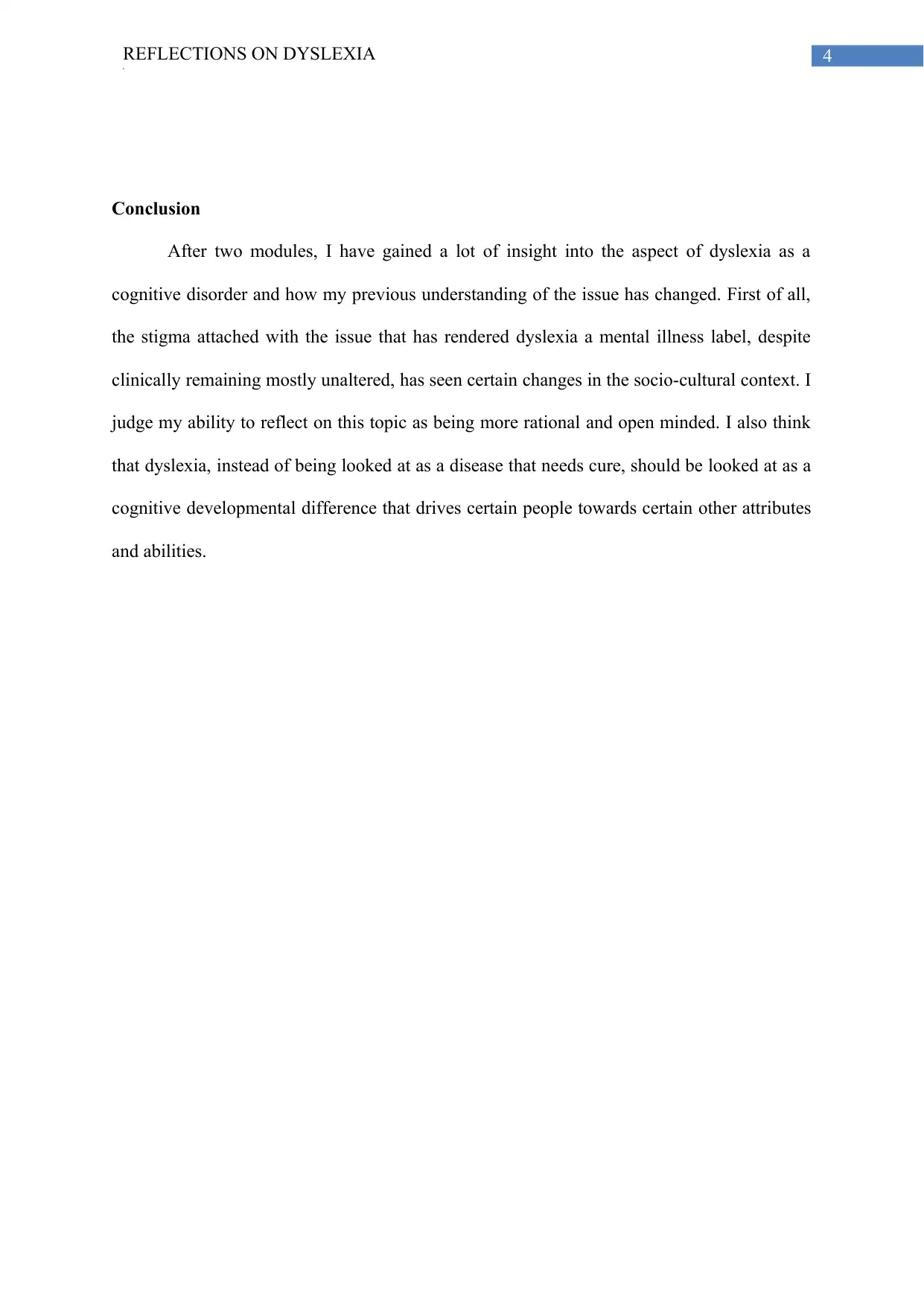
4REFLECTIONS ON DYSLEXIA
\
Conclusion
After two modules, I have gained a lot of insight into the aspect of dyslexia as a
cognitive disorder and how my previous understanding of the issue has changed. First of all,
the stigma attached with the issue that has rendered dyslexia a mental illness label, despite
clinically remaining mostly unaltered, has seen certain changes in the socio-cultural context. I
judge my ability to reflect on this topic as being more rational and open minded. I also think
that dyslexia, instead of being looked at as a disease that needs cure, should be looked at as a
cognitive developmental difference that drives certain people towards certain other attributes
and abilities.
\
Conclusion
After two modules, I have gained a lot of insight into the aspect of dyslexia as a
cognitive disorder and how my previous understanding of the issue has changed. First of all,
the stigma attached with the issue that has rendered dyslexia a mental illness label, despite
clinically remaining mostly unaltered, has seen certain changes in the socio-cultural context. I
judge my ability to reflect on this topic as being more rational and open minded. I also think
that dyslexia, instead of being looked at as a disease that needs cure, should be looked at as a
cognitive developmental difference that drives certain people towards certain other attributes
and abilities.
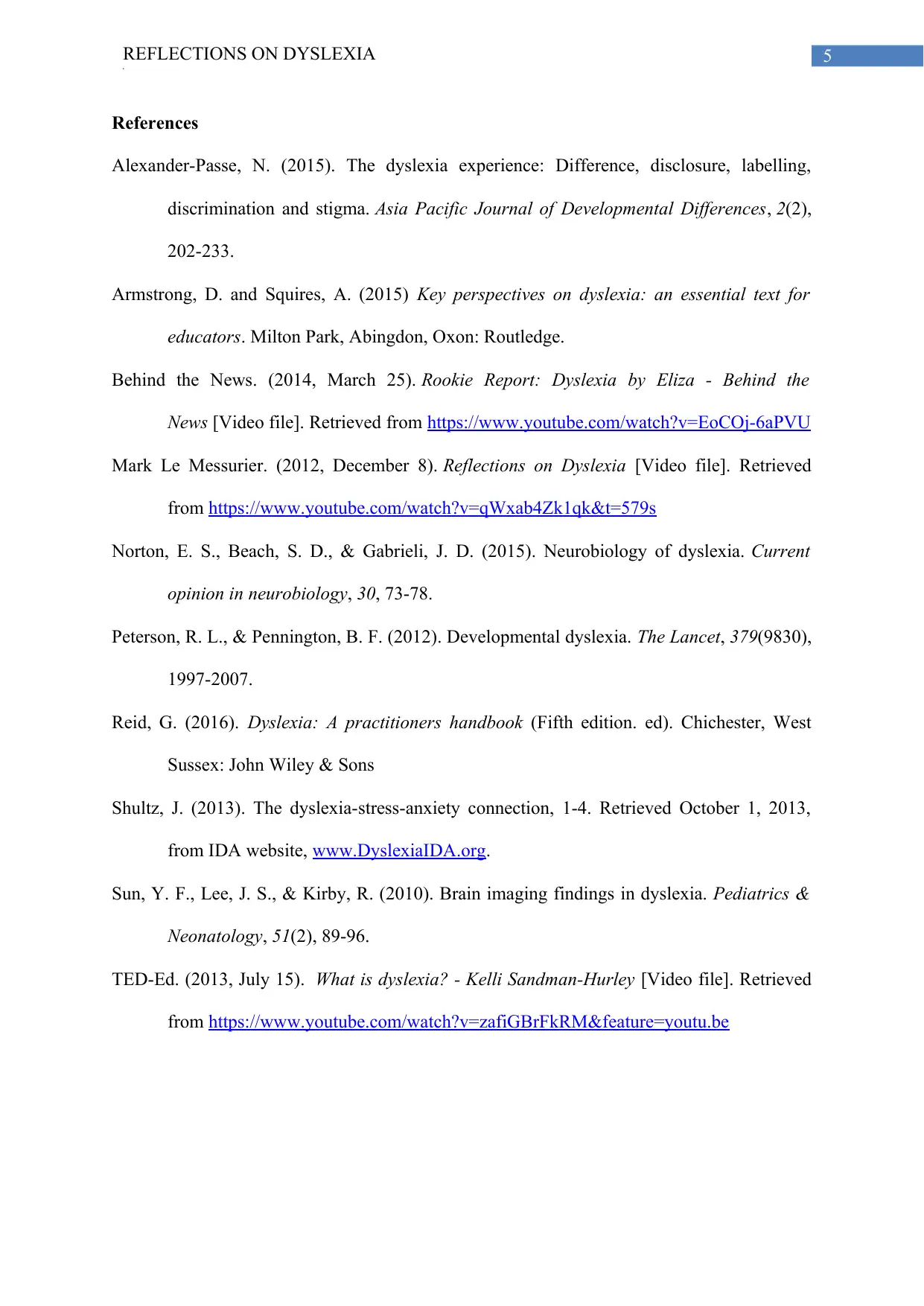
5REFLECTIONS ON DYSLEXIA
\
References
Alexander-Passe, N. (2015). The dyslexia experience: Difference, disclosure, labelling,
discrimination and stigma. Asia Pacific Journal of Developmental Differences, 2(2),
202-233.
Armstrong, D. and Squires, A. (2015) Key perspectives on dyslexia: an essential text for
educators. Milton Park, Abingdon, Oxon: Routledge.
Behind the News. (2014, March 25). Rookie Report: Dyslexia by Eliza - Behind the
News [Video file]. Retrieved from https://www.youtube.com/watch?v=EoCOj-6aPVU
Mark Le Messurier. (2012, December 8). Reflections on Dyslexia [Video file]. Retrieved
from https://www.youtube.com/watch?v=qWxab4Zk1qk&t=579s
Norton, E. S., Beach, S. D., & Gabrieli, J. D. (2015). Neurobiology of dyslexia. Current
opinion in neurobiology, 30, 73-78.
Peterson, R. L., & Pennington, B. F. (2012). Developmental dyslexia. The Lancet, 379(9830),
1997-2007.
Reid, G. (2016). Dyslexia: A practitioners handbook (Fifth edition. ed). Chichester, West
Sussex: John Wiley & Sons
Shultz, J. (2013). The dyslexia-stress-anxiety connection, 1-4. Retrieved October 1, 2013,
from IDA website, www.DyslexiaIDA.org.
Sun, Y. F., Lee, J. S., & Kirby, R. (2010). Brain imaging findings in dyslexia. Pediatrics &
Neonatology, 51(2), 89-96.
TED-Ed. (2013, July 15). What is dyslexia? - Kelli Sandman-Hurley [Video file]. Retrieved
from https://www.youtube.com/watch?v=zafiGBrFkRM&feature=youtu.be
\
References
Alexander-Passe, N. (2015). The dyslexia experience: Difference, disclosure, labelling,
discrimination and stigma. Asia Pacific Journal of Developmental Differences, 2(2),
202-233.
Armstrong, D. and Squires, A. (2015) Key perspectives on dyslexia: an essential text for
educators. Milton Park, Abingdon, Oxon: Routledge.
Behind the News. (2014, March 25). Rookie Report: Dyslexia by Eliza - Behind the
News [Video file]. Retrieved from https://www.youtube.com/watch?v=EoCOj-6aPVU
Mark Le Messurier. (2012, December 8). Reflections on Dyslexia [Video file]. Retrieved
from https://www.youtube.com/watch?v=qWxab4Zk1qk&t=579s
Norton, E. S., Beach, S. D., & Gabrieli, J. D. (2015). Neurobiology of dyslexia. Current
opinion in neurobiology, 30, 73-78.
Peterson, R. L., & Pennington, B. F. (2012). Developmental dyslexia. The Lancet, 379(9830),
1997-2007.
Reid, G. (2016). Dyslexia: A practitioners handbook (Fifth edition. ed). Chichester, West
Sussex: John Wiley & Sons
Shultz, J. (2013). The dyslexia-stress-anxiety connection, 1-4. Retrieved October 1, 2013,
from IDA website, www.DyslexiaIDA.org.
Sun, Y. F., Lee, J. S., & Kirby, R. (2010). Brain imaging findings in dyslexia. Pediatrics &
Neonatology, 51(2), 89-96.
TED-Ed. (2013, July 15). What is dyslexia? - Kelli Sandman-Hurley [Video file]. Retrieved
from https://www.youtube.com/watch?v=zafiGBrFkRM&feature=youtu.be
1 out of 6
Your All-in-One AI-Powered Toolkit for Academic Success.
+13062052269
info@desklib.com
Available 24*7 on WhatsApp / Email
![[object Object]](/_next/static/media/star-bottom.7253800d.svg)
Unlock your academic potential
© 2024 | Zucol Services PVT LTD | All rights reserved.
